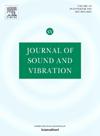Analysis of dynamic pull-in for lumped MEMS model of atomic force microscope with constant magnetic excitation
IF 4.3
2区 工程技术
Q1 ACOUSTICS
引用次数: 0
Abstract
We study the dynamical behavior of electromagnetically actuated MEMS cantilevers used in atomic force microscopy (AFM) in the non-contact working state. The nonlinear nature of the MEMS sensor’s tip-sample interaction, considered in the dynamic operation mode, must be appropriately modeled due to the van der Waals-type attraction/repulsion force. The resulting one-degree-of-freedom lumped parameter model constitutes the initial value problem for singular oscillator equation. The occurrence of pull-in solutions for this model with one magnetic excitation parameter is thoroughly analyzed. In particular, due to the Lorentz force-based electromagnetic actuation, we investigate two dynamic pull-in scenarios corresponding to a nonlinear system for which pull-in thresholds are analytically determined. Moreover, sufficient conditions for occurrence of pull-in or oscillatory solutions are rigorously derived and validated numerically. These results generalize those given previously, and can be useful for designing single-degree-of-freedom models of electromagnetically actuated MEMS cantilevers. Finally, we present and discuss a comparison between experimental data and theoretical predictions for a defined benchmark case.
恒磁激励原子力显微镜集总MEMS模型的动态拉入分析
研究了用于原子力显微镜(AFM)的电磁驱动MEMS悬臂梁在非接触工作状态下的动力学行为。在动态工作模式下,由于范德华引力/斥力的存在,MEMS传感器的尖端-样品相互作用的非线性性质必须适当地建模。由此得到的单自由度集总参数模型构成了奇异振子方程的初值问题。深入分析了单磁激励参数下模型拉入解的发生情况。特别地,由于基于洛伦兹力的电磁驱动,我们研究了两种动态拉入场景,对应于拉入阈值是解析确定的非线性系统。此外,严格推导了拉入解和振荡解存在的充分条件,并进行了数值验证。这些结果推广了先前给出的结果,可以用于设计电磁驱动MEMS悬臂梁的单自由度模型。最后,我们提出并讨论了一个定义基准案例的实验数据和理论预测之间的比较。
本文章由计算机程序翻译,如有差异,请以英文原文为准。
求助全文
约1分钟内获得全文
求助全文
来源期刊

Journal of Sound and Vibration
工程技术-工程:机械
CiteScore
9.10
自引率
10.60%
发文量
551
审稿时长
69 days
期刊介绍:
The Journal of Sound and Vibration (JSV) is an independent journal devoted to the prompt publication of original papers, both theoretical and experimental, that provide new information on any aspect of sound or vibration. There is an emphasis on fundamental work that has potential for practical application.
JSV was founded and operates on the premise that the subject of sound and vibration requires a journal that publishes papers of a high technical standard across the various subdisciplines, thus facilitating awareness of techniques and discoveries in one area that may be applicable in others.
 求助内容:
求助内容: 应助结果提醒方式:
应助结果提醒方式:


